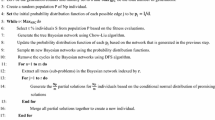Abstract
Heuristic algorithms, especially hill-climbing algorithms, are prone to being trapped by local optimization. Many researchers have focused on analyzing convergence and runtime of some heuristic algorithms on SAT-solving problems. However, there is rare work on analyzing success ratio (the ratio of the number of runs that find the global maxima of optimization versus the total runs) and expected fitness at each generation. Expected fitness at each generation could lead us to better understand the expected fitness of a heuristic algorithm could find on the problem to be solve at a certain generation. Success ratio help us understand with what a probability a heuristic algorithm could find the global optimization of the problem to be solved. So, this paper analyzed expected fitness and success ratio of two hill-climbing algorithms on two bimodal MaxSAT problems by using Markov chain. The theoretical and experimental results showed that though hill-climbing algorithms (both hill-climbing RandomWalk and Local (1+1)EA) converged faster, they could not always find global maxima of bimodal SAT-solving problems. The success ratios of hill-climbing algorithms usually have their own limits. The limit of success ratio is dependent on the SAT-solving problem itself and the expected distribution of initial bit string, and independent on whether hill-climbing RandomWalk or Local (1+1)EA is used.
Similar content being viewed by others
References
Cook, S.A.: The complexity of theorem-proving procedures. In: Proceedings of the Third Annual ACM Symposium on Theory of Computing 1971, Shaker Heights, Ohio, United States (1971)
Zhou Y., He J., Nie Q.: A comparative runtime analysis of heuristic algorithms for satisfiability problems. Artif. Intell. 173, 240–257 (2009)
Kusper G., Csõke L., Kovásznai G.: Simplifying the propositional satisfiability problem by sub-model propagation. Annales Mathematicae et Informaticae 35, 75–94 (2008)
Garey M.R., Johnson D.S.: Computers and Intractabilitya Guide to the Theory of NP-Completeness. Freeman, New York (1979)
Lardeux F., Saubion F., Hao J.K.: GASAT: a genetic local search algorithm for the satisfiability problem. Evol. Comput. 14, 223–253 (2006)
Gottlieb J., Marchiori E., Rossi C.: Evolutionary algorithms for the satisfiability problem. Evol. Comput. 10, 35–50 (2002)
Alekhnovich M., Ben-Sasson E.: Linear upper bounds for random walk on small density random 3-CNF. SIAM J. Comput. 36, 1248–1263 (2006)
Coja-Oghlan A, Feige U, Frieze A, Krivelevich M, et al.: On smoothed k-CNF formulas and the Walksat algorithm. In: Proceedings of 20th SODA, New York (2009)
Hirsch E.A., Kojevnikov A.: UnitWalk: A new SAT solver that uses local search guided by unit clause elimination. Ann. Math. Artif. Intell. 43, 91–111 (2005)
Kirkpatrick S., Gelatt C D., Vecchi M.P.: Optimization by simulated annealing. Science 220, 671–680 (1983)
Semerjian, G., Monasson, R.: A Study of pure random walk on random satisfiability problems with “physical” methods. In: Giunchiglia, E., Tacchella, A. (eds.) Proceedings of the SAT 2003 conference, Lecture Notes in Computer Science, vol. 2919, pp. 120–134 (2004)
Sasaki G.H., Hajek B.: The time complexity of maximum matching by simulated annealing. J. ACM 35, 387–403 (1988)
Garnier J., Kallel L.: Rigorous hitting times for binary mutations. Evol. Comput. 7, 173–203 (1999)
Krishnamachari B., Xie X., Selman B. et al.: Analysis of random noise and RandomWalk algorithms. Lecture Notes in Computer Science 1894, 278–290 (2000)
He J., Yao X.: Drift analysis and average time complexity of evolutionary algorithms. Artif. Intell. 127, 57–85 (2001)
Droste S., Jansen T., Wegener I.: On the analysis of the (1+1) evolutionary algorithm. Theor. Comput. Sci. 276, 51–81 (2002)
He J., Yao X.: Towards an analytic framework for analysing the computation time of evolutionary algorithms. Artif. Intell. 145, 59–97 (2003)
Oliveto P.S., He J., Yao X.: Time complexity of evolutionary algorithms for combinatorial optimization: a decade of results. Int. J. Autom. Comput. 4, 281–293 (2007)
Yu Y., Zhou Z.H.: A new approach to estimating the expected first hitting time of evolutionary algorithms. Artif. Intell. 172, 1809–1832 (2008)
Mahajan M., Raman V.: Parameterizing above guaranteed values: MaxSat and MaxCut. J. Algorithms 31, 335–354 (1999)
Du, D.Z., Gu, J., Pardalos, P.M. (eds.): Satisfiability Problem: Theory and Applications. DIMACS Series vol. 35, American Mathematical Society (1998)
Resende M.G.C., Pitsoulis L.S., Pardalos P.M.: FORTRAN subroutines for computing approximate solutions of weighted MAX-SAT problems using GRASP. Discret. Appl. Math. 100, 95–113 (1999)
Festa, P., Pardalos, P.M., Pitsoulis, L.S. et al.: GRASP with path relinking for the weighted MAXSAT problem. ACM J. Exp. Algorithmics. 11, 1–16, Article No. 2.4 (2006)
Hobert J.P., Tan A., Liu R.: When is Eaton’s Markov chain irreducible?. Bernoulli 13, 641–652 (2007)
Author information
Authors and Affiliations
Corresponding author
Rights and permissions
About this article
Cite this article
Lai, X., Zhou, Y. The analysis of expected fitness and success ratio of two heuristic optimizations on two bimodal MaxSAT problems. J Glob Optim 54, 745–764 (2012). https://doi.org/10.1007/s10898-011-9790-2
Received:
Accepted:
Published:
Issue Date:
DOI: https://doi.org/10.1007/s10898-011-9790-2




